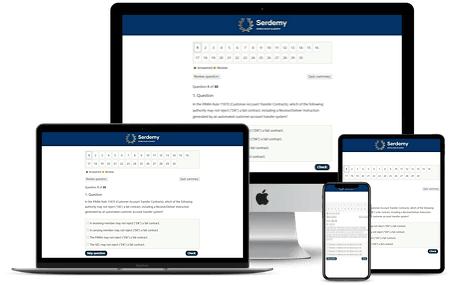Quiz-summary
0 of 30 questions completed
Questions:
- 1
- 2
- 3
- 4
- 5
- 6
- 7
- 8
- 9
- 10
- 11
- 12
- 13
- 14
- 15
- 16
- 17
- 18
- 19
- 20
- 21
- 22
- 23
- 24
- 25
- 26
- 27
- 28
- 29
- 30
Information
Premium Practice Questions
You have already completed the quiz before. Hence you can not start it again.
Quiz is loading...
You must sign in or sign up to start the quiz.
You have to finish following quiz, to start this quiz:
Results
0 of 30 questions answered correctly
Your time:
Time has elapsed
Categories
- Not categorized 0%
- 1
- 2
- 3
- 4
- 5
- 6
- 7
- 8
- 9
- 10
- 11
- 12
- 13
- 14
- 15
- 16
- 17
- 18
- 19
- 20
- 21
- 22
- 23
- 24
- 25
- 26
- 27
- 28
- 29
- 30
- Answered
- Review
-
Question 1 of 30
1. Question
As the General Securities Principal for Stellar Financial, a syndicate member in a highly anticipated initial public offering, you are tasked with reviewing the firm’s proposed allocations to ensure compliance with FINRA Rule 5130. Which of the following allocations would constitute a prohibited activity under this rule?
Correct
FINRA Rule 5130 is designed to ensure that the public has fair access to new issues and to prevent industry insiders from using their position to acquire shares in “hot issues” at the expense of their clients. The rule prohibits member firms from selling a new issue to any account in which a restricted person has a beneficial interest. A “restricted person” includes FINRA member firms and their associated persons. The definition also extends to the immediate family members of an associated person under certain conditions. An immediate family member, which includes a spouse, is considered a restricted person if they receive material support from the associated person, share a household with the associated person, or if the associated person is employed by the member selling the new issue and has the ability to control the allocation to the family member. In the scenario involving the joint account held by the Apex investment banker and their spouse, a violation occurs. The investment banker is an associated person of Apex Securities, the firm selling the new issue, and is therefore a restricted person. By virtue of being in a joint account, the banker has a direct beneficial interest in any securities held within it. Allocating shares of a new issue to an account where a restricted person has a beneficial interest is a direct violation of Rule 5130. The status of the spouse is also relevant; as they share a household with the associated person, the spouse is also independently considered a restricted person, further solidifying the prohibited nature of this allocation. The other scenarios described do not represent violations. The de minimis exemption allows allocations to accounts where restricted persons in aggregate hold no more than a 10% beneficial interest. The financially independent, non-cohabitating parent is not a restricted person under the rule’s specific conditions. Finally, the restriction on portfolio managers applies to their personal accounts, not the institutional funds they manage.
Incorrect
FINRA Rule 5130 is designed to ensure that the public has fair access to new issues and to prevent industry insiders from using their position to acquire shares in “hot issues” at the expense of their clients. The rule prohibits member firms from selling a new issue to any account in which a restricted person has a beneficial interest. A “restricted person” includes FINRA member firms and their associated persons. The definition also extends to the immediate family members of an associated person under certain conditions. An immediate family member, which includes a spouse, is considered a restricted person if they receive material support from the associated person, share a household with the associated person, or if the associated person is employed by the member selling the new issue and has the ability to control the allocation to the family member. In the scenario involving the joint account held by the Apex investment banker and their spouse, a violation occurs. The investment banker is an associated person of Apex Securities, the firm selling the new issue, and is therefore a restricted person. By virtue of being in a joint account, the banker has a direct beneficial interest in any securities held within it. Allocating shares of a new issue to an account where a restricted person has a beneficial interest is a direct violation of Rule 5130. The status of the spouse is also relevant; as they share a household with the associated person, the spouse is also independently considered a restricted person, further solidifying the prohibited nature of this allocation. The other scenarios described do not represent violations. The de minimis exemption allows allocations to accounts where restricted persons in aggregate hold no more than a 10% beneficial interest. The financially independent, non-cohabitating parent is not a restricted person under the rule’s specific conditions. Finally, the restriction on portfolio managers applies to their personal accounts, not the institutional funds they manage.
-
Question 2 of 30
2. Question
As the General Securities Principal at Apex Securities, a syndicate member for the Innovatech Corp. initial public offering (IPO), Mei is tasked with reviewing subscription indications to ensure compliance with FINRA Rule 5130. She must determine which of the following potential purchasers is eligible to buy shares in this new issue. Which indication should Mei approve?
Correct
The only permissible transaction under FINRA Rule 5130 is the purchase by the family investment partnership. The core purpose of FINRA Rule 5130 is to ensure that the public has fair access to new issue equity securities (IPOs) and to prevent broker-dealers and their associates from withholding these often sought-after securities for their own benefit. The rule accomplishes this by defining a category of “restricted persons” who are prohibited from purchasing new issues. Restricted persons include FINRA member firms, employees of member firms, finders and fiduciaries involved with the offering, portfolio managers with respect to their personal accounts, and persons owning a broker-dealer. The domestic bank is explicitly listed as a type of restricted person. The portfolio manager is also explicitly defined as a restricted person regarding purchases for their own account. The brother-in-law of a registered representative is considered an “immediate family member” under the rule. Immediate family members of restricted persons are also deemed restricted if they receive material support from the restricted person, share a household, or if the restricted person has the ability to control the allocation of the new issue to the family member. Given the relationship, this allocation would be prohibited as the representative is a restricted person. The family investment partnership is not inherently a restricted entity. Its status depends on the status of its beneficial owners. The rule provides a de minimis exemption, allowing an account to purchase a new issue if the beneficial interests of all restricted persons in the account do not exceed 10%. In this scenario, since none of the twelve beneficial owners are restricted persons, their collective interest is 0%, which is well below the 10% threshold, making the partnership eligible to purchase the IPO. Therefore, a principal must reject the indications from the bank, the portfolio manager, and the representative’s brother-in-law, but can approve the purchase for the partnership.
Incorrect
The only permissible transaction under FINRA Rule 5130 is the purchase by the family investment partnership. The core purpose of FINRA Rule 5130 is to ensure that the public has fair access to new issue equity securities (IPOs) and to prevent broker-dealers and their associates from withholding these often sought-after securities for their own benefit. The rule accomplishes this by defining a category of “restricted persons” who are prohibited from purchasing new issues. Restricted persons include FINRA member firms, employees of member firms, finders and fiduciaries involved with the offering, portfolio managers with respect to their personal accounts, and persons owning a broker-dealer. The domestic bank is explicitly listed as a type of restricted person. The portfolio manager is also explicitly defined as a restricted person regarding purchases for their own account. The brother-in-law of a registered representative is considered an “immediate family member” under the rule. Immediate family members of restricted persons are also deemed restricted if they receive material support from the restricted person, share a household, or if the restricted person has the ability to control the allocation of the new issue to the family member. Given the relationship, this allocation would be prohibited as the representative is a restricted person. The family investment partnership is not inherently a restricted entity. Its status depends on the status of its beneficial owners. The rule provides a de minimis exemption, allowing an account to purchase a new issue if the beneficial interests of all restricted persons in the account do not exceed 10%. In this scenario, since none of the twelve beneficial owners are restricted persons, their collective interest is 0%, which is well below the 10% threshold, making the partnership eligible to purchase the IPO. Therefore, a principal must reject the indications from the bank, the portfolio manager, and the representative’s brother-in-law, but can approve the purchase for the partnership.
-
Question 3 of 30
3. Question
Anya, a registered representative at Apex Brokerage, informs her supervising principal that she intends to assist her cousin’s technology start-up in raising capital from a small group of accredited investors. In return for her introductions and efforts, she will receive a 2% equity stake in the start-up but no direct cash commissions. After reviewing the details, the principal correctly identifies this as a private securities transaction where compensation is involved. Under FINRA Rule 3280, what is the firm’s primary obligation if it decides to permit Anya’s involvement?
Correct
The scenario describes a private securities transaction for which the associated person, Anya, will receive compensation. The compensation is non-cash (an equity stake), but it is still considered compensation under FINRA rules. FINRA Rule 3280 governs Private Securities Transactions of an Associated Person. The rule distinguishes between transactions where the associated person receives compensation and those where they do not. When an associated person proposes to engage in a private securities transaction for compensation, they must provide prior written notice to their member firm. The notice must describe the proposed transaction in detail and the person’s proposed role. Upon receiving this notice, the member firm has a specific set of obligations. The firm must explicitly approve the associated person’s participation in the transaction in writing. A critical consequence of this approval is that the member firm must then record the transaction on its own books and records. Furthermore, the firm is required to supervise the associated person’s participation as if the transaction were being executed on behalf of the member firm itself. This means the full scope of the firm’s supervisory procedures under FINRA Rule 3110 would apply to Anya’s activities in the capital raise. The firm cannot simply acknowledge the activity; it must either disapprove it or approve it and assume full supervisory responsibility.
Incorrect
The scenario describes a private securities transaction for which the associated person, Anya, will receive compensation. The compensation is non-cash (an equity stake), but it is still considered compensation under FINRA rules. FINRA Rule 3280 governs Private Securities Transactions of an Associated Person. The rule distinguishes between transactions where the associated person receives compensation and those where they do not. When an associated person proposes to engage in a private securities transaction for compensation, they must provide prior written notice to their member firm. The notice must describe the proposed transaction in detail and the person’s proposed role. Upon receiving this notice, the member firm has a specific set of obligations. The firm must explicitly approve the associated person’s participation in the transaction in writing. A critical consequence of this approval is that the member firm must then record the transaction on its own books and records. Furthermore, the firm is required to supervise the associated person’s participation as if the transaction were being executed on behalf of the member firm itself. This means the full scope of the firm’s supervisory procedures under FINRA Rule 3110 would apply to Anya’s activities in the capital raise. The firm cannot simply acknowledge the activity; it must either disapprove it or approve it and assume full supervisory responsibility.
-
Question 4 of 30
4. Question
To ensure regulatory compliance for a significant business expansion, a General Securities Principal must evaluate the necessary filings and procedural updates. Consider the case of Apex Strategies LLC, a FINRA member firm that currently employs 80 registered representatives. The firm’s Chief Compliance Officer, Anjali, is overseeing the acquisition of a specialized team of 25 representatives from a rival firm. This acquisition will enable Apex to launch a new private placement advisory division. Given this scenario, which course of action correctly addresses Anjali’s primary obligations under FINRA rules regarding the business expansion?
Correct
The first step is to determine if the change in business constitutes a “material change in business operations” under FINRA rules. This is assessed by calculating the percentage increase in the number of registered representatives. The firm is adding 25 representatives to its existing staff of 80. The calculation is \(\frac{25}{80} = 0.3125\), which represents a 31.25% increase. According to FINRA Rule 1017 and its related interpretive material, a member firm that seeks to undergo a material change in business operations must file a Continuing Membership Application (CMA). The rules provide specific examples of what is presumed to be a material change, one of which is an increase of 25% or more in the number of the member’s associated persons. Since the 31.25% increase exceeds this 25% threshold, the firm is required to file a CMA with FINRA. This application must be submitted at least 30 days before the proposed change is to take effect. In addition to the regulatory filing, the principal has a direct supervisory obligation under FINRA Rule 3110. This rule requires member firms to establish, maintain, and enforce Written Supervisory Procedures (WSPs) that are reasonably designed to achieve compliance with applicable securities laws and regulations. A significant expansion, such as adding a new business line like private placement advisory services and integrating a large team of new personnel, necessitates a thorough review and amendment of the firm’s WSPs. The procedures must be updated to cover the specific risks, activities, and supervisory structure of the new division and personnel. Therefore, the comprehensive and correct course of action involves both the external regulatory filing and the update of the internal supervisory framework.
Incorrect
The first step is to determine if the change in business constitutes a “material change in business operations” under FINRA rules. This is assessed by calculating the percentage increase in the number of registered representatives. The firm is adding 25 representatives to its existing staff of 80. The calculation is \(\frac{25}{80} = 0.3125\), which represents a 31.25% increase. According to FINRA Rule 1017 and its related interpretive material, a member firm that seeks to undergo a material change in business operations must file a Continuing Membership Application (CMA). The rules provide specific examples of what is presumed to be a material change, one of which is an increase of 25% or more in the number of the member’s associated persons. Since the 31.25% increase exceeds this 25% threshold, the firm is required to file a CMA with FINRA. This application must be submitted at least 30 days before the proposed change is to take effect. In addition to the regulatory filing, the principal has a direct supervisory obligation under FINRA Rule 3110. This rule requires member firms to establish, maintain, and enforce Written Supervisory Procedures (WSPs) that are reasonably designed to achieve compliance with applicable securities laws and regulations. A significant expansion, such as adding a new business line like private placement advisory services and integrating a large team of new personnel, necessitates a thorough review and amendment of the firm’s WSPs. The procedures must be updated to cover the specific risks, activities, and supervisory structure of the new division and personnel. Therefore, the comprehensive and correct course of action involves both the external regulatory filing and the update of the internal supervisory framework.
-
Question 5 of 30
5. Question
Anika, a General Securities Principal, discovers that Liam, one of her registered representatives, recently received a finder’s fee for introducing his uncle to a venture capital firm, which resulted in a private placement investment in a non-public tech company. Liam did not provide any prior written notice to the firm about this activity. In her capacity as principal, what is Anika’s most critical and immediate regulatory obligation upon concluding that a violation of FINRA Rule 3280 has occurred?
Correct
No calculation is required. The solution is based on the application of FINRA rules. The situation described involves a private securities transaction (PST) as defined by FINRA Rule 3280. This rule governs the activities of an associated person who engages in a securities transaction outside the regular course or scope of their employment with a member firm. Because the representative received compensation in the form of a finder’s fee, the transaction is considered a compensated PST. For such transactions, the rule requires the associated person to provide prior written notice to the firm. The firm must then evaluate the transaction and the representative’s participation, and if it approves, it must record the transaction on its books and records and supervise the activity as if it were its own. In this scenario, the representative failed to provide any prior written notice, which is a direct violation of Rule 3280. When a principal discovers such a violation, their supervisory duties are triggered. The firm cannot simply retroactively approve the transaction to cure the violation. The failure to provide notice is, in itself, a significant breach of conduct rules. According to FINRA Rule 4530, a member firm is required to report to FINRA within 30 calendar days of having a reasonable basis to conclude that an associated person has violated any securities, insurance, commodities, financial, or investment-related laws, rules, regulations, or standards of conduct. The undisclosed and unapproved compensated PST is a clear violation that necessitates such a report. In addition to the mandatory regulatory reporting, the principal must also determine and implement appropriate internal disciplinary actions, which could range from a formal warning and heightened supervision to termination of employment.
Incorrect
No calculation is required. The solution is based on the application of FINRA rules. The situation described involves a private securities transaction (PST) as defined by FINRA Rule 3280. This rule governs the activities of an associated person who engages in a securities transaction outside the regular course or scope of their employment with a member firm. Because the representative received compensation in the form of a finder’s fee, the transaction is considered a compensated PST. For such transactions, the rule requires the associated person to provide prior written notice to the firm. The firm must then evaluate the transaction and the representative’s participation, and if it approves, it must record the transaction on its books and records and supervise the activity as if it were its own. In this scenario, the representative failed to provide any prior written notice, which is a direct violation of Rule 3280. When a principal discovers such a violation, their supervisory duties are triggered. The firm cannot simply retroactively approve the transaction to cure the violation. The failure to provide notice is, in itself, a significant breach of conduct rules. According to FINRA Rule 4530, a member firm is required to report to FINRA within 30 calendar days of having a reasonable basis to conclude that an associated person has violated any securities, insurance, commodities, financial, or investment-related laws, rules, regulations, or standards of conduct. The undisclosed and unapproved compensated PST is a clear violation that necessitates such a report. In addition to the mandatory regulatory reporting, the principal must also determine and implement appropriate internal disciplinary actions, which could range from a formal warning and heightened supervision to termination of employment.
-
Question 6 of 30
6. Question
Anya, a registered representative at Keystone Securities, provides her supervising principal with written notice of her intent to assist her uncle, Mr. Chen, in raising capital for his new, privately-held technology company. The notice discloses that Anya will receive equity in Mr. Chen’s company as compensation for her role in the capital raise, which will involve introducing accredited investors to the opportunity. Under FINRA Rule 3280, if Keystone Securities approves Anya’s participation, what is the firm’s primary supervisory obligation regarding this activity?
Correct
This question does not require a mathematical calculation. The scenario described involves a private securities transaction (PST) under FINRA Rule 3280, not merely an outside business activity (OBA) under FINRA Rule 3270. A PST is any securities transaction outside the regular course or scope of an associated person’s employment with a member firm. The critical distinction here is that the representative will be receiving compensation (in the form of equity). According to FINRA Rule 3280, if an associated person is to receive compensation for their participation in a private securities transaction, they must first provide written notice to their member firm. The notice must describe the proposed transaction in detail and state the person’s proposed role and any compensation they will receive. The member firm must then, in writing, either approve or disapprove the person’s participation. If the member firm approves the participation, the rule imposes a significant supervisory burden. The firm must record the transaction on its own books and records. Furthermore, it must supervise the associated person’s participation in the transaction as if the transaction were being executed on behalf of the member firm itself. This means the firm assumes full supervisory responsibility for the representative’s conduct in the transaction, including suitability determinations and all other applicable securities rules and regulations. The firm cannot simply approve the activity and then disregard it; it must be treated as part of the firm’s own business from a supervisory standpoint.
Incorrect
This question does not require a mathematical calculation. The scenario described involves a private securities transaction (PST) under FINRA Rule 3280, not merely an outside business activity (OBA) under FINRA Rule 3270. A PST is any securities transaction outside the regular course or scope of an associated person’s employment with a member firm. The critical distinction here is that the representative will be receiving compensation (in the form of equity). According to FINRA Rule 3280, if an associated person is to receive compensation for their participation in a private securities transaction, they must first provide written notice to their member firm. The notice must describe the proposed transaction in detail and state the person’s proposed role and any compensation they will receive. The member firm must then, in writing, either approve or disapprove the person’s participation. If the member firm approves the participation, the rule imposes a significant supervisory burden. The firm must record the transaction on its own books and records. Furthermore, it must supervise the associated person’s participation in the transaction as if the transaction were being executed on behalf of the member firm itself. This means the firm assumes full supervisory responsibility for the representative’s conduct in the transaction, including suitability determinations and all other applicable securities rules and regulations. The firm cannot simply approve the activity and then disregard it; it must be treated as part of the firm’s own business from a supervisory standpoint.
-
Question 7 of 30
7. Question
Apex Securities, a FINRA member firm, plans to provide its institutional clients with research reports produced by an unaffiliated, independent research provider, Verity Analytics. The reports will feature both the Apex Securities and Verity Analytics logos. For the supervising principal at Apex, which action represents the most critical supervisory obligation under FINRA Rule 2241 before these co-branded reports are distributed?
Correct
The core issue revolves around a member firm’s supervisory responsibilities when distributing third-party research, particularly when it is co-branded. According to FINRA Rule 2241, when a member firm distributes or makes available third-party research, it must adhere to specific supervisory procedures. If the firm presents the third-party research as its own, for instance by co-branding it with the firm’s logo, it is treated as if the member firm itself authored the report. This act of adoption significantly heightens the firm’s supervisory obligations. In such a scenario, the distributing firm (Apex Securities) assumes responsibility for the content of the research. Therefore, the firm’s written supervisory procedures must mandate that a registered principal with supervisory authority reviews and approves the research report before it is distributed. This approval process is to ensure the report is fair, balanced, not misleading, and complies with all applicable provisions of Rule 2241. Simply verifying the third-party’s internal compliance, seeking legal indemnification, or following general advertising filing rules does not substitute for this fundamental requirement of content approval by a qualified principal of the distributing firm. The act of co-branding makes the report, for regulatory purposes, the product of Apex Securities, necessitating the same level of internal supervisory scrutiny as research produced in-house.
Incorrect
The core issue revolves around a member firm’s supervisory responsibilities when distributing third-party research, particularly when it is co-branded. According to FINRA Rule 2241, when a member firm distributes or makes available third-party research, it must adhere to specific supervisory procedures. If the firm presents the third-party research as its own, for instance by co-branding it with the firm’s logo, it is treated as if the member firm itself authored the report. This act of adoption significantly heightens the firm’s supervisory obligations. In such a scenario, the distributing firm (Apex Securities) assumes responsibility for the content of the research. Therefore, the firm’s written supervisory procedures must mandate that a registered principal with supervisory authority reviews and approves the research report before it is distributed. This approval process is to ensure the report is fair, balanced, not misleading, and complies with all applicable provisions of Rule 2241. Simply verifying the third-party’s internal compliance, seeking legal indemnification, or following general advertising filing rules does not substitute for this fundamental requirement of content approval by a qualified principal of the distributing firm. The act of co-branding makes the report, for regulatory purposes, the product of Apex Securities, necessitating the same level of internal supervisory scrutiny as research produced in-house.
-
Question 8 of 30
8. Question
Alistair, a General Securities Principal at Apex Securities, is reviewing a proposed action by his firm’s research department. Apex is acting as a co-manager in the upcoming initial public offering for Innovate Corp., a technology company. A senior research analyst, whose work is independent of the investment banking department, has prepared a comprehensive “Quarterly Tech Sector Outlook” report. This report analyzes 15 different technology companies, including Innovate Corp., and is scheduled for publication during the pre-effective period of the IPO. In determining whether the publication of this research report is permissible under the Securities Act of 1933, which of the following is Alistair’s most critical consideration?
Correct
The primary regulation governing the publication of research reports by a broker-dealer that is also participating in a securities distribution is Securities Act Rule 139. This rule provides a safe harbor, allowing a firm to publish research without it being considered an illegal offer or prospectus, provided certain conditions are met. The rule distinguishes between issuer-specific reports and industry-wide reports. In the case of an industry report that includes the issuer in question, the most critical conditions for the safe harbor are that the report is published in the normal course of business and that the information, opinions, or recommendations concerning the issuer receiving the distribution are not given materially greater space or prominence than that given to other companies in the report. This requirement is central to ensuring the communication is a legitimate, broad-based research product and not a disguised marketing effort to hype the specific security being offered. While other supervisory elements like information barriers and restrictions on analyst compensation are crucial components of overall compliance under FINRA Rule 2241, they do not in themselves grant the safe harbor for the content of the report itself. The specific construction of the report and the equitable treatment of the issuer within it are the paramount considerations for complying with the Rule 139 safe harbor. Therefore, a principal’s most direct and critical task is to analyze the report’s content to ensure it does not give undue prominence to the issuer involved in the offering.
Incorrect
The primary regulation governing the publication of research reports by a broker-dealer that is also participating in a securities distribution is Securities Act Rule 139. This rule provides a safe harbor, allowing a firm to publish research without it being considered an illegal offer or prospectus, provided certain conditions are met. The rule distinguishes between issuer-specific reports and industry-wide reports. In the case of an industry report that includes the issuer in question, the most critical conditions for the safe harbor are that the report is published in the normal course of business and that the information, opinions, or recommendations concerning the issuer receiving the distribution are not given materially greater space or prominence than that given to other companies in the report. This requirement is central to ensuring the communication is a legitimate, broad-based research product and not a disguised marketing effort to hype the specific security being offered. While other supervisory elements like information barriers and restrictions on analyst compensation are crucial components of overall compliance under FINRA Rule 2241, they do not in themselves grant the safe harbor for the content of the report itself. The specific construction of the report and the equitable treatment of the issuer within it are the paramount considerations for complying with the Rule 139 safe harbor. Therefore, a principal’s most direct and critical task is to analyze the report’s content to ensure it does not give undue prominence to the issuer involved in the offering.
-
Question 9 of 30
9. Question
Assessment of a proposed underwriting arrangement at Apex Capital Partners, a FINRA member firm, reveals a significant issue. Apex is slated to be the sole underwriter for a follow-on public offering of common stock for Innovate Dynamics Inc. The principal’s due diligence confirms that Apex currently holds 12% of Innovate Dynamics’ outstanding common stock. Furthermore, Innovate Dynamics’ stock is thinly traded on the OTC market and does not meet the requirements for a bona fide public market, nor does the company have any investment-grade rated debt. Given these facts, which supervisory action is mandated by FINRA Rule 5121 for Apex to proceed with the offering?
Correct
The situation describes a conflict of interest under FINRA Rule 5121 because the member firm, Apex Capital Partners, owns more than 10% of the common equity of the issuer, Innovate Dynamics Inc. When such a conflict exists, the member firm cannot participate in the public offering unless specific conditions are met. The rule provides two primary exemptions that would allow the firm to proceed without appointing a Qualified Independent Underwriter (QIU). The first is if the issuer has a bona fide public market for the securities being offered, which generally means the security has a trading history on a national exchange and meets certain volume and shareholder requirements. The second is if the securities being offered are investment-grade fixed income securities or the issuer has investment-grade securities outstanding that have seniority or are pari passu with the offered security. In this scenario, neither of these exemptions applies. The issuer’s stock is not actively traded and does not have a bona fide public market, and there is no mention of investment-grade securities. Therefore, to proceed with the underwriting, Apex Capital Partners is required to engage a QIU. The QIU must be a member firm that does not have a conflict of interest in the offering and meets certain experience criteria. The QIU’s primary responsibilities are to participate in the preparation of the registration statement and to exercise the usual standards of due diligence with respect to the offering. The prospectus for the offering must prominently disclose the nature of the conflict of interest, state that the offering is being conducted in compliance with Rule 5121, and identify the QIU.
Incorrect
The situation describes a conflict of interest under FINRA Rule 5121 because the member firm, Apex Capital Partners, owns more than 10% of the common equity of the issuer, Innovate Dynamics Inc. When such a conflict exists, the member firm cannot participate in the public offering unless specific conditions are met. The rule provides two primary exemptions that would allow the firm to proceed without appointing a Qualified Independent Underwriter (QIU). The first is if the issuer has a bona fide public market for the securities being offered, which generally means the security has a trading history on a national exchange and meets certain volume and shareholder requirements. The second is if the securities being offered are investment-grade fixed income securities or the issuer has investment-grade securities outstanding that have seniority or are pari passu with the offered security. In this scenario, neither of these exemptions applies. The issuer’s stock is not actively traded and does not have a bona fide public market, and there is no mention of investment-grade securities. Therefore, to proceed with the underwriting, Apex Capital Partners is required to engage a QIU. The QIU must be a member firm that does not have a conflict of interest in the offering and meets certain experience criteria. The QIU’s primary responsibilities are to participate in the preparation of the registration statement and to exercise the usual standards of due diligence with respect to the offering. The prospectus for the offering must prominently disclose the nature of the conflict of interest, state that the offering is being conducted in compliance with Rule 5121, and identify the QIU.
-
Question 10 of 30
10. Question
Anjali is the Head of Compliance for Apex Capital, a broker-dealer acting as a co-manager for the upcoming Initial Public Offering of Innovate Corp. Ken, a research analyst at Apex, submits a draft research report on the “Cloud Computing” sector for Anjali’s approval. The report prominently features Innovate Corp., including a detailed valuation analysis. Ken also discloses to Anjali that he holds a small, pre-IPO equity position in Innovate Corp., acquired two years prior. Assessment of this situation from a supervisory perspective requires Anjali to prioritize the most critical regulatory constraint. Which of the following actions correctly addresses the primary compliance obligation?
Correct
The analysis begins by identifying the key regulatory constraints applicable to the scenario. The firm, Apex Capital, is a co-manager in the Initial Public Offering (IPO) of Innovate Corp. The firm’s research department intends to publish a report that prominently features Innovate Corp. This situation directly implicates FINRA Rule 2241, which governs research analyst conflicts of interest and the publication of research reports. A critical component of FINRA Rule 2241 is the imposition of “quiet periods” around public offerings. For an IPO, a firm that acts as a manager or co-manager is prohibited from publishing or distributing a research report concerning the subject company for 10 calendar days following the date of the offering. The proposed report, by prominently featuring Innovate Corp. and its valuation, clearly constitutes a research report concerning the subject company. Therefore, its publication during the IPO process and for 10 days after is strictly prohibited. While the analyst’s personal holdings in Innovate Corp. do constitute a conflict of interest under Rule 2241 and would require disclosure, and the firm’s role as an underwriter creates a conflict under FINRA Rule 5121 that requires specific disclosures in the offering documents, these issues are secondary to the absolute prohibition imposed by the quiet period rule. The quiet period is not a waivable condition that can be cured by disclosure. It is a mandatory blackout period. The principal’s primary supervisory duty in this context is to enforce this prohibition. The correct action is to prevent the publication of the research report until the mandated 10-day quiet period following the IPO has concluded. Allowing publication with disclosures would be a direct violation of FINRA rules.
Incorrect
The analysis begins by identifying the key regulatory constraints applicable to the scenario. The firm, Apex Capital, is a co-manager in the Initial Public Offering (IPO) of Innovate Corp. The firm’s research department intends to publish a report that prominently features Innovate Corp. This situation directly implicates FINRA Rule 2241, which governs research analyst conflicts of interest and the publication of research reports. A critical component of FINRA Rule 2241 is the imposition of “quiet periods” around public offerings. For an IPO, a firm that acts as a manager or co-manager is prohibited from publishing or distributing a research report concerning the subject company for 10 calendar days following the date of the offering. The proposed report, by prominently featuring Innovate Corp. and its valuation, clearly constitutes a research report concerning the subject company. Therefore, its publication during the IPO process and for 10 days after is strictly prohibited. While the analyst’s personal holdings in Innovate Corp. do constitute a conflict of interest under Rule 2241 and would require disclosure, and the firm’s role as an underwriter creates a conflict under FINRA Rule 5121 that requires specific disclosures in the offering documents, these issues are secondary to the absolute prohibition imposed by the quiet period rule. The quiet period is not a waivable condition that can be cured by disclosure. It is a mandatory blackout period. The principal’s primary supervisory duty in this context is to enforce this prohibition. The correct action is to prevent the publication of the research report until the mandated 10-day quiet period following the IPO has concluded. Allowing publication with disclosures would be a direct violation of FINRA rules.
-
Question 11 of 30
11. Question
An assessment of Vanguardia Capital’s current business reveals that its M&A advisory group is providing confidential advice to InnovateSphere Inc. on a potential takeover bid. Concurrently, Vanguardia’s investment banking department is acting as a lead underwriter for a large secondary offering of InnovateSphere stock, and the firm’s research department maintains an active “Buy” recommendation on the company. As the General Securities Principal responsible for supervising these areas, which of the following actions is the most critical and comprehensive step to ensure compliance and mitigate regulatory risk?
Correct
The core issue involves managing multiple, significant conflicts of interest and the potential for misuse of material non-public information (MNPI). The firm is simultaneously engaged in investment banking (underwriting), M&A advisory, and research activities for the same issuer. The most critical supervisory responsibility is to prevent the flow of information between these departments. The M&A advisory group is in possession of significant MNPI regarding a potential acquisition. This information cannot be shared with the research department, as it would compromise the integrity of their public reports, nor with the underwriting team in a way that could be used improperly. Likewise, the investment banking relationship cannot unduly influence the research department’s objectivity. Therefore, the paramount supervisory action is the implementation and rigorous enforcement of information barriers, often called Chinese Walls. These are policies and procedures designed to segregate departments and control the flow of confidential information. This includes physical separation of departments, restricted access to electronic files, surveillance of communications, and maintaining watch and restricted lists. While disclosing the underwriting conflict in the research report is required by FINRA Rule 2241, and using a qualified independent underwriter may be necessary under certain FINRA Rule 5121 conditions, neither action addresses the primary risk of MNPI leakage from the M&A division. Establishing robust information barriers is the foundational control mechanism that must be in place to manage these concurrent, conflicting roles and prevent violations of insider trading regulations under the Securities Exchange Act of 1934.
Incorrect
The core issue involves managing multiple, significant conflicts of interest and the potential for misuse of material non-public information (MNPI). The firm is simultaneously engaged in investment banking (underwriting), M&A advisory, and research activities for the same issuer. The most critical supervisory responsibility is to prevent the flow of information between these departments. The M&A advisory group is in possession of significant MNPI regarding a potential acquisition. This information cannot be shared with the research department, as it would compromise the integrity of their public reports, nor with the underwriting team in a way that could be used improperly. Likewise, the investment banking relationship cannot unduly influence the research department’s objectivity. Therefore, the paramount supervisory action is the implementation and rigorous enforcement of information barriers, often called Chinese Walls. These are policies and procedures designed to segregate departments and control the flow of confidential information. This includes physical separation of departments, restricted access to electronic files, surveillance of communications, and maintaining watch and restricted lists. While disclosing the underwriting conflict in the research report is required by FINRA Rule 2241, and using a qualified independent underwriter may be necessary under certain FINRA Rule 5121 conditions, neither action addresses the primary risk of MNPI leakage from the M&A division. Establishing robust information barriers is the foundational control mechanism that must be in place to manage these concurrent, conflicting roles and prevent violations of insider trading regulations under the Securities Exchange Act of 1934.
-
Question 12 of 30
12. Question
Apex Prime Brokerage, a FINRA member firm, files a complete Form BDW on March 1st to voluntarily withdraw its registration. The withdrawal is scheduled to become effective 60 days later. On April 15th, during this 60-day period, the firm’s principal learns that Leo, a registered representative at Apex, has just been convicted of a felony for embezzlement. From a supervisory standpoint, what is the principal’s most critical and immediate obligation?
Correct
The primary issue revolves around a member firm’s obligations during the period after it has filed for withdrawal (Form BDW) but before the withdrawal becomes effective. According to FINRA By-Laws, a firm remains a member and is subject to all FINRA rules and jurisdiction until its withdrawal is declared effective by FINRA, which is typically 60 days after the filing of a complete Form BDW. Furthermore, FINRA By-Laws Article V, Section 4 establishes that FINRA retains jurisdiction over a terminated associated person for two years following the filing of their Form U5. In this scenario, the firm is still an active member when the disqualifying event occurs. The felony conviction for embezzlement constitutes a statutory disqualification under Section 3(a)(39) of the Securities Exchange Act of 1934. FINRA Rule 4530 requires firms to report specified events, including statutory disqualifications. When an associated person is terminated, this disclosure is made on Form U5. An amendment to Form U5 disclosing a statutory disqualification must be filed within 10 days of the firm discovering the event. The principal’s responsibility is to ensure compliance with this reporting requirement. The firm’s pending withdrawal does not negate its obligation to report events that occur while it is still an active member. Therefore, the firm must file or amend Leo’s Form U5 to disclose the conviction within the mandated 10-day timeframe.
Incorrect
The primary issue revolves around a member firm’s obligations during the period after it has filed for withdrawal (Form BDW) but before the withdrawal becomes effective. According to FINRA By-Laws, a firm remains a member and is subject to all FINRA rules and jurisdiction until its withdrawal is declared effective by FINRA, which is typically 60 days after the filing of a complete Form BDW. Furthermore, FINRA By-Laws Article V, Section 4 establishes that FINRA retains jurisdiction over a terminated associated person for two years following the filing of their Form U5. In this scenario, the firm is still an active member when the disqualifying event occurs. The felony conviction for embezzlement constitutes a statutory disqualification under Section 3(a)(39) of the Securities Exchange Act of 1934. FINRA Rule 4530 requires firms to report specified events, including statutory disqualifications. When an associated person is terminated, this disclosure is made on Form U5. An amendment to Form U5 disclosing a statutory disqualification must be filed within 10 days of the firm discovering the event. The principal’s responsibility is to ensure compliance with this reporting requirement. The firm’s pending withdrawal does not negate its obligation to report events that occur while it is still an active member. Therefore, the firm must file or amend Leo’s Form U5 to disclose the conviction within the mandated 10-day timeframe.
-
Question 13 of 30
13. Question
A General Securities Principal at an underwriting firm is reviewing a proposal for an upcoming follow-on offering for an issuer that qualifies as a Well-Known Seasoned Issuer (WKSI). The investment banking team intends to distribute a detailed marketing brochure, which qualifies as a free writing prospectus (FWP), to potential institutional investors several days before the registration statement is filed with the SEC. To ensure compliance with the Securities Act of 1933, what is the most critical supervisory determination the principal must make regarding this proposed communication?
Correct
The determination is based on the specific provisions of Securities Act Rule 163, which grants a unique exemption for Well-Known Seasoned Issuers (WKSIs). A WKSI is generally an issuer that is eligible to use Form S-3 or F-3 and has either a worldwide market value of outstanding voting and non-voting common equity held by non-affiliates of $700 million or more, or has issued at least $1 billion in aggregate principal amount of non-convertible securities, other than common equity, in primary offerings for cash in the past three years. Rule 163 allows a WKSI to engage in oral and written communications at any time, including before a registration statement is filed. These written communications are defined as a free writing prospectus (FWP). For a pre-filing FWP to be permissible under Rule 163, two key conditions must be met. First, the FWP must include a specific legend indicating that the issuer may file a registration statement and that a written prospectus, when available, should be read. Second, the FWP must be filed with the SEC promptly upon the filing of the registration statement, or an amendment to it, covering the securities offered. For FWPs used before the registration statement is filed, this means the FWP must be filed with the SEC no later than the date of its first use. This is a critical distinction from the rules for non-WKSIs, who generally may only use an FWP after a registration statement has been filed and must be preceded or accompanied by a statutory prospectus, as outlined in Rule 433. The supervisory principal must verify these specific WKSI conditions are met to ensure compliance.
Incorrect
The determination is based on the specific provisions of Securities Act Rule 163, which grants a unique exemption for Well-Known Seasoned Issuers (WKSIs). A WKSI is generally an issuer that is eligible to use Form S-3 or F-3 and has either a worldwide market value of outstanding voting and non-voting common equity held by non-affiliates of $700 million or more, or has issued at least $1 billion in aggregate principal amount of non-convertible securities, other than common equity, in primary offerings for cash in the past three years. Rule 163 allows a WKSI to engage in oral and written communications at any time, including before a registration statement is filed. These written communications are defined as a free writing prospectus (FWP). For a pre-filing FWP to be permissible under Rule 163, two key conditions must be met. First, the FWP must include a specific legend indicating that the issuer may file a registration statement and that a written prospectus, when available, should be read. Second, the FWP must be filed with the SEC promptly upon the filing of the registration statement, or an amendment to it, covering the securities offered. For FWPs used before the registration statement is filed, this means the FWP must be filed with the SEC no later than the date of its first use. This is a critical distinction from the rules for non-WKSIs, who generally may only use an FWP after a registration statement has been filed and must be preceded or accompanied by a statutory prospectus, as outlined in Rule 433. The supervisory principal must verify these specific WKSI conditions are met to ensure compliance.
-
Question 14 of 30
14. Question
Ananya, a General Securities Principal at Apex Capital Partners, is reviewing a large order from a new institutional client, Quantum Leap Fund, LP, for a sought-after initial public offering (IPO). During her due diligence, Ananya discovers that one of Quantum Leap’s limited partners is a registered representative at an unaffiliated FINRA member firm. To determine if Quantum Leap Fund, LP can purchase the IPO shares in compliance with FINRA Rule 5130, what is the most critical determination Ananya must make regarding the fund’s eligibility?
Correct
The core issue is determining the eligibility of a collective investment account, which includes a restricted person, to purchase shares in an initial public offering (IPO) under FINRA Rule 5130. The rule defines restricted persons to include FINRA member firms and their associated persons. When a collective investment account, such as a hedge fund, has beneficial owners who are restricted persons, the account itself is deemed restricted. However, the rule provides a de minimis exemption. This exemption permits a collective investment account to purchase a new issue if the aggregate beneficial interest of all restricted persons in the account does not exceed 10 percent of the total account ownership. To rely on this exemption, the broker-dealer must have, or must obtain, a written representation from the account’s manager, dated within the previous 12 months, attesting that the aggregate beneficial interest of restricted persons is below the 10 percent threshold. Therefore, the principal’s primary responsibility is to verify this specific percentage limit and ensure the proper documentation is in place. The purpose of this rule is to foster a fair and public distribution of new issues and prevent industry insiders from using their position to gain preferential access to IPOs. The principal’s verification confirms that the fund’s participation does not concentrate the new issue among restricted persons beyond the allowable limit.
Incorrect
The core issue is determining the eligibility of a collective investment account, which includes a restricted person, to purchase shares in an initial public offering (IPO) under FINRA Rule 5130. The rule defines restricted persons to include FINRA member firms and their associated persons. When a collective investment account, such as a hedge fund, has beneficial owners who are restricted persons, the account itself is deemed restricted. However, the rule provides a de minimis exemption. This exemption permits a collective investment account to purchase a new issue if the aggregate beneficial interest of all restricted persons in the account does not exceed 10 percent of the total account ownership. To rely on this exemption, the broker-dealer must have, or must obtain, a written representation from the account’s manager, dated within the previous 12 months, attesting that the aggregate beneficial interest of restricted persons is below the 10 percent threshold. Therefore, the principal’s primary responsibility is to verify this specific percentage limit and ensure the proper documentation is in place. The purpose of this rule is to foster a fair and public distribution of new issues and prevent industry insiders from using their position to gain preferential access to IPOs. The principal’s verification confirms that the fund’s participation does not concentrate the new issue among restricted persons beyond the allowable limit.
-
Question 15 of 30
15. Question
The Chief Executive Officer of Keystone Capital Markets, Ms. Anya Sharma, is preparing to execute the firm’s annual certification of compliance and supervisory processes. The firm’s Chief Compliance Officer (CCO) has compiled a comprehensive report detailing the firm’s supervisory control system for her review. In accordance with the specific provisions of FINRA Rule 3130, which of the following is a mandatory prerequisite that must be fulfilled before Ms. Sharma can validly sign the certification?
Correct
FINRA Rule 3130 mandates that a member firm’s Chief Executive Officer or an equivalent officer must certify annually that the firm has in place processes to establish, maintain, review, test, and modify its written supervisory procedures. A critical and explicit prerequisite to this certification is a formal meeting between the CEO and the Chief Compliance Officer. This meeting, or meetings, must occur within the 12 months preceding the execution of the certification. The purpose of this interaction is for the CEO and CCO to have a substantive discussion regarding the firm’s compliance posture. This includes reviewing the operational status of the firm’s supervisory systems, discussing the effectiveness of its compliance programs, and addressing any identified material compliance problems and plans for their remediation. The rule ensures that the highest level of executive management is directly engaged with and informed about the firm’s compliance framework before attesting to its adequacy. The certification itself confirms that the firm’s procedures are reasonably designed to achieve compliance with all applicable securities laws, regulations, and FINRA rules. This meeting requirement underscores that the CEO’s certification is not a mere formality but is based on direct, high-level consultation and review of the firm’s compliance functions.
Incorrect
FINRA Rule 3130 mandates that a member firm’s Chief Executive Officer or an equivalent officer must certify annually that the firm has in place processes to establish, maintain, review, test, and modify its written supervisory procedures. A critical and explicit prerequisite to this certification is a formal meeting between the CEO and the Chief Compliance Officer. This meeting, or meetings, must occur within the 12 months preceding the execution of the certification. The purpose of this interaction is for the CEO and CCO to have a substantive discussion regarding the firm’s compliance posture. This includes reviewing the operational status of the firm’s supervisory systems, discussing the effectiveness of its compliance programs, and addressing any identified material compliance problems and plans for their remediation. The rule ensures that the highest level of executive management is directly engaged with and informed about the firm’s compliance framework before attesting to its adequacy. The certification itself confirms that the firm’s procedures are reasonably designed to achieve compliance with all applicable securities laws, regulations, and FINRA rules. This meeting requirement underscores that the CEO’s certification is not a mere formality but is based on direct, high-level consultation and review of the firm’s compliance functions.
-
Question 16 of 30
16. Question
Apex Securities’ investment banking department is in the final stages of negotiating an advisory role for a follow-on offering for Quantum Innovations Inc. Dr. Lena Petrova, a senior research analyst at Apex who covers Quantum, is scheduled for a live television interview to discuss the tech sector, and Quantum is a likely topic. As the supervising principal, what is the most critical action to ensure compliance with FINRA Rule 2241 and Regulation AC regarding Dr. Petrova’s appearance?
Correct
Under FINRA Rule 2241, specific disclosures are required when a research analyst makes a public appearance. The supervising principal must ensure these requirements are met. A public appearance includes unscripted interviews on television or radio. If the analyst discusses a subject company for which their member firm has received compensation from investment banking services in the past 12 months, or if the member firm expects to receive or intends to seek compensation for such services in the next 3 months, the analyst must disclose this fact. The rule does not require the analyst to be prohibited from speaking, but rather mandates transparency regarding this potential conflict of interest. Furthermore, SEC Regulation AC requires that the analyst provides a certification that the views expressed in the research report or public appearance accurately reflect their personal views. For a public appearance, this attestation can be made in writing beforehand or stated during the appearance itself. Therefore, the principal’s duty is to ensure the analyst is aware of and prepared to make both the required conflict of interest disclosure under FINRA rules and the personal views attestation required by Regulation AC. Simply disclosing other potential conflicts, like the firm’s stock ownership, is insufficient if the specific investment banking conflict exists. The rules favor disclosure over outright prohibition of such appearances.
Incorrect
Under FINRA Rule 2241, specific disclosures are required when a research analyst makes a public appearance. The supervising principal must ensure these requirements are met. A public appearance includes unscripted interviews on television or radio. If the analyst discusses a subject company for which their member firm has received compensation from investment banking services in the past 12 months, or if the member firm expects to receive or intends to seek compensation for such services in the next 3 months, the analyst must disclose this fact. The rule does not require the analyst to be prohibited from speaking, but rather mandates transparency regarding this potential conflict of interest. Furthermore, SEC Regulation AC requires that the analyst provides a certification that the views expressed in the research report or public appearance accurately reflect their personal views. For a public appearance, this attestation can be made in writing beforehand or stated during the appearance itself. Therefore, the principal’s duty is to ensure the analyst is aware of and prepared to make both the required conflict of interest disclosure under FINRA rules and the personal views attestation required by Regulation AC. Simply disclosing other potential conflicts, like the firm’s stock ownership, is insufficient if the specific investment banking conflict exists. The rules favor disclosure over outright prohibition of such appearances.
-
Question 17 of 30
17. Question
An assessment of Apex Capital Partners’ upcoming underwriting engagement reveals that the firm owns 12% of the common stock of the issuer, Innovate Robotics Corp. Apex is slated to be the sole underwriter for Innovate’s secondary public offering. Leto, the General Securities Principal at Apex, is tasked with ensuring the offering complies with all applicable FINRA regulations. To proceed with this offering, which of the following sets of actions must Leto ensure the firm implements to comply with FINRA Rule 5121?
Correct
FINRA Rule 5121 addresses conflicts of interest that arise when a member firm participates in a public offering of its own securities or those of an affiliate. A conflict of interest is presumed to exist if, among other things, the member firm owns 10% or more of the common equity of the issuer. In this scenario, Apex Capital Partners’ 12% ownership stake in Innovate Robotics Corp. creates a conflict of interest. To proceed with the underwriting, the rule requires the firm to satisfy one of two main conditions. The first, and most common, is to engage a qualified independent underwriter (QIU). The QIU must not have a conflict of interest, must have served as an underwriter in at least three similar public offerings in the preceding three years, and must participate in the preparation of the registration statement and perform the usual standards of due diligence. Furthermore, the prospectus must feature prominent disclosure on its cover page detailing the nature of the conflict. The name of the QIU must also be disclosed. The price of the security must be no higher than that recommended by the QIU. The second condition, which bypasses the need for a QIU, applies if the security has a bona fide public market or is investment-grade, but even then, the disclosure requirements about the conflict remain. The most comprehensive and correct procedure involves both the structural participation of a QIU in due diligence and pricing, as well as prominent, specific disclosure to investors.
Incorrect
FINRA Rule 5121 addresses conflicts of interest that arise when a member firm participates in a public offering of its own securities or those of an affiliate. A conflict of interest is presumed to exist if, among other things, the member firm owns 10% or more of the common equity of the issuer. In this scenario, Apex Capital Partners’ 12% ownership stake in Innovate Robotics Corp. creates a conflict of interest. To proceed with the underwriting, the rule requires the firm to satisfy one of two main conditions. The first, and most common, is to engage a qualified independent underwriter (QIU). The QIU must not have a conflict of interest, must have served as an underwriter in at least three similar public offerings in the preceding three years, and must participate in the preparation of the registration statement and perform the usual standards of due diligence. Furthermore, the prospectus must feature prominent disclosure on its cover page detailing the nature of the conflict. The name of the QIU must also be disclosed. The price of the security must be no higher than that recommended by the QIU. The second condition, which bypasses the need for a QIU, applies if the security has a bona fide public market or is investment-grade, but even then, the disclosure requirements about the conflict remain. The most comprehensive and correct procedure involves both the structural participation of a QIU in due diligence and pricing, as well as prominent, specific disclosure to investors.
-
Question 18 of 30
18. Question
Apex Securities, a broker-dealer, is acting as a co-manager for the upcoming initial public offering of Innovate Robotics Inc. The firm’s investment banking department informs Li Wei, a General Securities Principal, that Innovate Robotics is hosting an exclusive “technology symposium” for select analysts and industry experts just before the quiet period begins. The bankers suggest that Apex’s lead robotics research analyst, Dr. Anya Sharma, should attend to enhance her due diligence. To address the potential conflict of interest under FINRA Rule 2241, what is the most appropriate supervisory action for Li Wei to take?
Correct
The core issue revolves around FINRA Rule 2241, which establishes strict information barriers and rules to manage conflicts of interest between a firm’s research department and its investment banking department. The rule’s purpose is to promote the objectivity and independence of research analysts. A key prohibition under this rule is that research analysts may not participate in efforts to solicit investment banking business, which includes any communication with a company for the purpose of soliciting business, often referred to as a pitch meeting. Furthermore, investment banking personnel are prohibited from directing a research analyst to engage in any communication with a current or prospective customer or with an issuer for the purpose of soliciting investment banking business. In the scenario presented, the firm is a co-manager for an IPO. The issuer is hosting a symposium, which, regardless of its stated purpose, creates a high-risk environment for a conflict of interest. Allowing the research analyst to attend, especially at the suggestion of the investment banking department, could be viewed as a violation of the strict separation required. Even if chaperoned, the analyst’s presence at an issuer-sponsored event so close to an offering could be construed as participating in a road show or other marketing activity, which is forbidden. The most stringent and appropriate supervisory action is to enforce the information barrier absolutely. This means prohibiting the analyst from attending the event to avoid any appearance of impropriety or potential influence from the investment banking department or the issuer. Due diligence must be conducted through formally approved and properly chaperoned channels that do not involve joint activities that could compromise the analyst’s independence.
Incorrect
The core issue revolves around FINRA Rule 2241, which establishes strict information barriers and rules to manage conflicts of interest between a firm’s research department and its investment banking department. The rule’s purpose is to promote the objectivity and independence of research analysts. A key prohibition under this rule is that research analysts may not participate in efforts to solicit investment banking business, which includes any communication with a company for the purpose of soliciting business, often referred to as a pitch meeting. Furthermore, investment banking personnel are prohibited from directing a research analyst to engage in any communication with a current or prospective customer or with an issuer for the purpose of soliciting investment banking business. In the scenario presented, the firm is a co-manager for an IPO. The issuer is hosting a symposium, which, regardless of its stated purpose, creates a high-risk environment for a conflict of interest. Allowing the research analyst to attend, especially at the suggestion of the investment banking department, could be viewed as a violation of the strict separation required. Even if chaperoned, the analyst’s presence at an issuer-sponsored event so close to an offering could be construed as participating in a road show or other marketing activity, which is forbidden. The most stringent and appropriate supervisory action is to enforce the information barrier absolutely. This means prohibiting the analyst from attending the event to avoid any appearance of impropriety or potential influence from the investment banking department or the issuer. Due diligence must be conducted through formally approved and properly chaperoned channels that do not involve joint activities that could compromise the analyst’s independence.
-
Question 19 of 30
19. Question
An assessment of the pre-IPO procedures at Zenith Securities reveals that the firm is acting as lead underwriter for a major technology offering. The head of investment banking proposes several ways to leverage the expertise of the firm’s highly-regarded technology research analyst, Anika Sharma. As the supervising principal responsible for enforcing the firm’s written supervisory procedures under FINRA Rule 2241, which of the following proposed activities must you immediately prohibit?
Correct
The analysis of this scenario is governed by FINRA Rule 2241, which establishes strict information barriers and delineates permissible and prohibited activities between a firm’s research department and its investment banking department to prevent conflicts of interest and promote analyst objectivity. The core principle of the rule is to ensure that research is not used as a marketing tool to attract or retain investment banking business. Consequently, there are explicit prohibitions on certain interactions. One of the most critical prohibitions is that research analysts are not permitted to participate in efforts to solicit investment banking services business. This includes, but is not limited to, participating in pitch meetings with prospective investment banking clients (the issuer) or engaging in other communications with the issuer for the purpose of securing an underwriting mandate. While analysts are barred from soliciting business, the rule does permit certain communications for due diligence purposes. An analyst may communicate with investment banking personnel and the issuer to verify factual information for a research report, provided these communications are properly chaperoned by legal or compliance personnel. This ensures the communication is for accuracy and not to influence the research outcome. Furthermore, an analyst’s compensation cannot be tied directly to a specific investment banking transaction. However, it can be based on the firm’s overall investment banking revenue as one of many factors, provided the compensation is determined by a committee that does not include investment banking personnel and the specific contribution to IB services is not considered. Finally, educating the firm’s internal sales force about a transaction or a research report is a standard and permissible part of an analyst’s duties.
Incorrect
The analysis of this scenario is governed by FINRA Rule 2241, which establishes strict information barriers and delineates permissible and prohibited activities between a firm’s research department and its investment banking department to prevent conflicts of interest and promote analyst objectivity. The core principle of the rule is to ensure that research is not used as a marketing tool to attract or retain investment banking business. Consequently, there are explicit prohibitions on certain interactions. One of the most critical prohibitions is that research analysts are not permitted to participate in efforts to solicit investment banking services business. This includes, but is not limited to, participating in pitch meetings with prospective investment banking clients (the issuer) or engaging in other communications with the issuer for the purpose of securing an underwriting mandate. While analysts are barred from soliciting business, the rule does permit certain communications for due diligence purposes. An analyst may communicate with investment banking personnel and the issuer to verify factual information for a research report, provided these communications are properly chaperoned by legal or compliance personnel. This ensures the communication is for accuracy and not to influence the research outcome. Furthermore, an analyst’s compensation cannot be tied directly to a specific investment banking transaction. However, it can be based on the firm’s overall investment banking revenue as one of many factors, provided the compensation is determined by a committee that does not include investment banking personnel and the specific contribution to IB services is not considered. Finally, educating the firm’s internal sales force about a transaction or a research report is a standard and permissible part of an analyst’s duties.
-
Question 20 of 30
20. Question
Apex Global Partners, a broker-dealer, recently acted as a co-manager in an initial public offering for Innovate Robotics Corp. Lena, a research analyst at Apex who covers the technology sector, initiates coverage on Innovate Robotics 20 days after the IPO’s effective date with a “Buy” rating. A week later, Lena participates in a widely attended industry webcast. During the Q&A session, she is asked about her outlook on Innovate Robotics. Lena reiterates her “Buy” rating and mentions that “our investment banking division has a great working relationship with their management team.” She does not make any other disclosures regarding the firm’s relationship with Innovate Robotics. An assessment of this situation by the firm’s General Securities Principal would identify which of the following as the most significant supervisory failure?
Correct
This question does not require a calculation. The solution is based on the application of FINRA Rule 2241, which governs research analysts and research reports. The primary supervisory failure in this scenario is the lack of proper procedures to ensure the analyst makes all required disclosures during a public appearance. FINRA Rule 2241(c)(4) mandates specific disclosures when a research analyst makes a public appearance, which includes webcasts. Among the required disclosures are whether the member firm has received compensation from the subject company for investment banking services in the past 12 months. The analyst’s statement about the firm’s relationship with the issuer’s management, while potentially problematic, does not fulfill this specific disclosure requirement. The most significant supervisory breakdown is the failure to ensure the analyst clearly and specifically disclosed the firm’s recent receipt of investment banking compensation, which represents a material conflict of interest. While other disclosures, such as personal holdings, are also required, the failure to disclose the firm-level investment banking conflict is a critical lapse in supervisory oversight under FINRA rules designed to protect the investing public from potential biases in research. A principal is responsible for establishing, maintaining, and enforcing written supervisory procedures reasonably designed to ensure that analysts comply with all disclosure requirements during public appearances.
Incorrect
This question does not require a calculation. The solution is based on the application of FINRA Rule 2241, which governs research analysts and research reports. The primary supervisory failure in this scenario is the lack of proper procedures to ensure the analyst makes all required disclosures during a public appearance. FINRA Rule 2241(c)(4) mandates specific disclosures when a research analyst makes a public appearance, which includes webcasts. Among the required disclosures are whether the member firm has received compensation from the subject company for investment banking services in the past 12 months. The analyst’s statement about the firm’s relationship with the issuer’s management, while potentially problematic, does not fulfill this specific disclosure requirement. The most significant supervisory breakdown is the failure to ensure the analyst clearly and specifically disclosed the firm’s recent receipt of investment banking compensation, which represents a material conflict of interest. While other disclosures, such as personal holdings, are also required, the failure to disclose the firm-level investment banking conflict is a critical lapse in supervisory oversight under FINRA rules designed to protect the investing public from potential biases in research. A principal is responsible for establishing, maintaining, and enforcing written supervisory procedures reasonably designed to ensure that analysts comply with all disclosure requirements during public appearances.
-
Question 21 of 30
21. Question
An assessment of the following situation by a General Securities Principal is required. Apex Securities acted as a co-manager for Quantum Innovations Inc.’s secondary stock offering, which was completed 40 days ago. An Apex research analyst who covers Quantum is scheduled for a public appearance on a major financial news network to discuss the company’s prospects. To comply with FINRA Rule 2241 and SEC Regulation AC, what is the most appropriate supervisory action for the principal to take regarding the analyst’s appearance?
Correct
The core of this scenario involves the supervisory responsibilities for a research analyst’s public appearance under FINRA Rule 2241 and SEC Regulation AC. A principal must ensure that all required disclosures are made to maintain transparency and manage conflicts of interest. First, under FINRA Rule 2241, when a research analyst makes a public appearance, they must disclose if their firm has received compensation for investment banking services from the subject company in the past 12 months. In this case, Apex Securities acted as a co-manager for Quantum’s secondary offering 40 days ago, which clearly falls within the 12-month look-back period. Therefore, the existence of this investment banking relationship and the receipt of compensation must be disclosed. The rule does not require the disclosure of the specific dollar amount of the compensation, only the fact that it was received. Second, SEC Regulation AC (Analyst Certification) requires that in public appearances, the research analyst makes a statement that the views they are expressing are their own personal views. This certification is a key component of ensuring research integrity. The quiet period for a manager or co-manager of a secondary offering is 3 days following the effective date. Since 40 days have passed, the analyst is not prohibited from making the public appearance. Prohibiting the appearance would be an incorrect supervisory action. Finally, requiring pre-approval of talking points from the subject company is strictly against research independence rules. While a draft report might be submitted for a limited factual review, an analyst’s public statements cannot be pre-cleared by the company they cover. Therefore, the principal’s correct course of action is to ensure the analyst makes the required disclosures regarding the past investment banking relationship and a certification of their personal views.
Incorrect
The core of this scenario involves the supervisory responsibilities for a research analyst’s public appearance under FINRA Rule 2241 and SEC Regulation AC. A principal must ensure that all required disclosures are made to maintain transparency and manage conflicts of interest. First, under FINRA Rule 2241, when a research analyst makes a public appearance, they must disclose if their firm has received compensation for investment banking services from the subject company in the past 12 months. In this case, Apex Securities acted as a co-manager for Quantum’s secondary offering 40 days ago, which clearly falls within the 12-month look-back period. Therefore, the existence of this investment banking relationship and the receipt of compensation must be disclosed. The rule does not require the disclosure of the specific dollar amount of the compensation, only the fact that it was received. Second, SEC Regulation AC (Analyst Certification) requires that in public appearances, the research analyst makes a statement that the views they are expressing are their own personal views. This certification is a key component of ensuring research integrity. The quiet period for a manager or co-manager of a secondary offering is 3 days following the effective date. Since 40 days have passed, the analyst is not prohibited from making the public appearance. Prohibiting the appearance would be an incorrect supervisory action. Finally, requiring pre-approval of talking points from the subject company is strictly against research independence rules. While a draft report might be submitted for a limited factual review, an analyst’s public statements cannot be pre-cleared by the company they cover. Therefore, the principal’s correct course of action is to ensure the analyst makes the required disclosures regarding the past investment banking relationship and a certification of their personal views.
-
Question 22 of 30
22. Question
An assessment of Apex Capital Partners’ upcoming IPO for Innovate Robotics Corp. reveals two distinct compliance issues requiring the attention of the General Securities Principal, Mei. First, a director of Apex owns 12% of Innovate Robotics’ pre-offering stock. Second, a registered representative at Apex, Kenji, who is not part of the investment banking department, has requested an allocation of IPO shares for his personal account. Which of the following correctly outlines Mei’s required supervisory actions under FINRA rules?
Correct
The scenario presents two distinct regulatory issues that a General Securities Principal must address under FINRA rules. The first issue involves a conflict of interest under FINRA Rule 5121, and the second involves the purchase of a new issue by a restricted person under FINRA Rule 5130. The first issue is the 12% ownership stake held by a director of the underwriting firm, Apex Capital Partners, in the issuer, Innovate Robotics Corp. FINRA Rule 5121 defines a conflict of interest to exist if the member or its affiliates beneficially own 10% or more of the common equity of the company for which the member is underwriting an offering. Since the director is an affiliate of the member firm and owns 12%, a conflict of interest exists. When such a conflict exists, the rule requires, among other things, that the member firm engage a Qualified Independent Underwriter (QIU). The QIU must participate in the preparation of the registration statement and prospectus and exercise the usual standards of due diligence. Simply disclosing the conflict is insufficient; the QIU is a mandatory procedural safeguard. The second issue concerns the request from Kenji, a registered representative at Apex, to purchase IPO shares. FINRA Rule 5130 defines “restricted persons” who are prohibited from purchasing shares in an initial public offering of equity securities. This definition explicitly includes any associated person of a member firm. Kenji’s role within the firm is irrelevant; his status as an associated person makes him a restricted person. Therefore, he is prohibited from purchasing the IPO shares for his personal account. The principal must deny this request to ensure compliance with Rule 5130. Combining these two points, the correct supervisory action is to both engage a QIU to manage the conflict of interest and to prohibit the associated person from participating in the IPO.
Incorrect
The scenario presents two distinct regulatory issues that a General Securities Principal must address under FINRA rules. The first issue involves a conflict of interest under FINRA Rule 5121, and the second involves the purchase of a new issue by a restricted person under FINRA Rule 5130. The first issue is the 12% ownership stake held by a director of the underwriting firm, Apex Capital Partners, in the issuer, Innovate Robotics Corp. FINRA Rule 5121 defines a conflict of interest to exist if the member or its affiliates beneficially own 10% or more of the common equity of the company for which the member is underwriting an offering. Since the director is an affiliate of the member firm and owns 12%, a conflict of interest exists. When such a conflict exists, the rule requires, among other things, that the member firm engage a Qualified Independent Underwriter (QIU). The QIU must participate in the preparation of the registration statement and prospectus and exercise the usual standards of due diligence. Simply disclosing the conflict is insufficient; the QIU is a mandatory procedural safeguard. The second issue concerns the request from Kenji, a registered representative at Apex, to purchase IPO shares. FINRA Rule 5130 defines “restricted persons” who are prohibited from purchasing shares in an initial public offering of equity securities. This definition explicitly includes any associated person of a member firm. Kenji’s role within the firm is irrelevant; his status as an associated person makes him a restricted person. Therefore, he is prohibited from purchasing the IPO shares for his personal account. The principal must deny this request to ensure compliance with Rule 5130. Combining these two points, the correct supervisory action is to both engage a QIU to manage the conflict of interest and to prohibit the associated person from participating in the IPO.
-
Question 23 of 30
23. Question
The following situation unfolds at Apex Capital Partners, a broker-dealer. Dr. Lena Petrova, a research analyst, has published a research report with a “Buy” recommendation for BioGen Innovations Inc. She is scheduled to make a public appearance at a widely attended conference to discuss her thesis. The day before the conference, Marcus Thorne, her supervising principal, learns of two distinct developments. First, Apex’s investment banking department has been retained by a competitor to explore a potential acquisition of BioGen, and this material non-public information has been placed behind a strict information barrier, with Dr. Petrova having no knowledge of it. Second, new data from a foreign clinical trial has become publicly available, and it appears to challenge a key assumption underlying Dr. Petrova’s “Buy” recommendation. What is Marcus Thorne’s most critical supervisory obligation under FINRA rules regarding Dr. Petrova’s imminent public appearance?
Correct
The primary supervisory responsibility is to ensure the integrity and reasonable basis of the analyst’s public statements, as mandated by FINRA Rule 2241 and SEC Regulation AC. The investment banking engagement with PharmaCorp is a significant conflict, but it is managed by the firm’s information barrier. As long as the barrier is maintained and the analyst, Dr. Petrova, is not aware of the non-public information, her speech is not directly compromised by that specific event. The more immediate and critical issue is the emergence of new, publicly available data that contradicts the analyst’s published research. FINRA Rule 2241 requires that research reports and public appearances have a reasonable basis. If new information comes to light that could reasonably be expected to change the basis of a recommendation, a principal cannot allow an analyst to publicly reiterate the old opinion without addressing the new data. Doing so would mean the statements made during the public appearance may no longer be fair, balanced, or based on a reasonable foundation. The principal’s duty is not to dictate the analyst’s opinion but to ensure the process for forming and communicating that opinion is sound. Therefore, the principal must ensure the analyst reviews the new data. If the analyst’s view changes, this must be disclosed during the appearance. If there is insufficient time to fully analyze the new data, the analyst should disclose that her prior views are under review based on new information. This action directly addresses the requirement for maintaining a reasonable basis for public communications. Canceling the appearance is an extreme step and may not be necessary if proper disclosures can be made. Reinforcing the information barrier is important but does not address the separate issue of the new public data.
Incorrect
The primary supervisory responsibility is to ensure the integrity and reasonable basis of the analyst’s public statements, as mandated by FINRA Rule 2241 and SEC Regulation AC. The investment banking engagement with PharmaCorp is a significant conflict, but it is managed by the firm’s information barrier. As long as the barrier is maintained and the analyst, Dr. Petrova, is not aware of the non-public information, her speech is not directly compromised by that specific event. The more immediate and critical issue is the emergence of new, publicly available data that contradicts the analyst’s published research. FINRA Rule 2241 requires that research reports and public appearances have a reasonable basis. If new information comes to light that could reasonably be expected to change the basis of a recommendation, a principal cannot allow an analyst to publicly reiterate the old opinion without addressing the new data. Doing so would mean the statements made during the public appearance may no longer be fair, balanced, or based on a reasonable foundation. The principal’s duty is not to dictate the analyst’s opinion but to ensure the process for forming and communicating that opinion is sound. Therefore, the principal must ensure the analyst reviews the new data. If the analyst’s view changes, this must be disclosed during the appearance. If there is insufficient time to fully analyze the new data, the analyst should disclose that her prior views are under review based on new information. This action directly addresses the requirement for maintaining a reasonable basis for public communications. Canceling the appearance is an extreme step and may not be necessary if proper disclosures can be made. Reinforcing the information barrier is important but does not address the separate issue of the new public data.
-
Question 24 of 30
24. Question
A General Securities Principal at Keystone Brokerage is conducting a pre-publication review of a research report on Quantum Dynamics Inc., prepared by a senior analyst. Keystone’s investment banking division acted as a co-manager for a secondary offering for Quantum Dynamics that was completed 10 months ago. Additionally, Keystone’s trading desk actively makes a market in Quantum’s common stock. The analyst’s report is downgrading the stock from “Buy” to “Hold.” In fulfilling their supervisory duties under FINRA Rule 2241, which of the following represents the most critical verification the principal must perform regarding the report’s content?
Correct
This is a conceptual question and does not require any mathematical calculation. Under FINRA Rule 2241, member firms must establish and maintain robust written supervisory procedures to manage conflicts of interest related to the publication and distribution of research reports. A supervising principal has a critical responsibility to review research reports before publication to ensure compliance with these rules. The rules are designed to provide transparency to investors regarding potential biases that could influence a research analyst’s recommendation. Specifically, when a member firm has a conflict, certain disclosures are mandatory within the research report itself. If the member firm makes a market in the subject company’s securities, this fact must be clearly disclosed. Furthermore, FINRA Rule 2241 mandates disclosure if the member firm has managed or co-managed a public offering of securities for the subject company or has received any compensation for investment banking services from the subject company in the preceding 12 months. The rule also requires disclosure if the firm expects to receive or intends to seek such compensation in the next 3 months. In addition to these firm-level disclosures, SEC Regulation AC (Analyst Certification) requires that the research report includes a certification from the research analyst. This certification must state two key things: first, that the views expressed in the report accurately reflect the analyst’s personal views about the subject securities or issuers, and second, that no part of the analyst’s compensation was, is, or will be, directly or indirectly, related to the specific recommendations or views expressed by the analyst in the research report. The principal’s review must confirm that these certifications are present and that there is no information to suggest they are inaccurate. The combination of verifying these specific, mandatory disclosures and the analyst’s personal certification is the cornerstone of supervising research in the presence of such conflicts.
Incorrect
This is a conceptual question and does not require any mathematical calculation. Under FINRA Rule 2241, member firms must establish and maintain robust written supervisory procedures to manage conflicts of interest related to the publication and distribution of research reports. A supervising principal has a critical responsibility to review research reports before publication to ensure compliance with these rules. The rules are designed to provide transparency to investors regarding potential biases that could influence a research analyst’s recommendation. Specifically, when a member firm has a conflict, certain disclosures are mandatory within the research report itself. If the member firm makes a market in the subject company’s securities, this fact must be clearly disclosed. Furthermore, FINRA Rule 2241 mandates disclosure if the member firm has managed or co-managed a public offering of securities for the subject company or has received any compensation for investment banking services from the subject company in the preceding 12 months. The rule also requires disclosure if the firm expects to receive or intends to seek such compensation in the next 3 months. In addition to these firm-level disclosures, SEC Regulation AC (Analyst Certification) requires that the research report includes a certification from the research analyst. This certification must state two key things: first, that the views expressed in the report accurately reflect the analyst’s personal views about the subject securities or issuers, and second, that no part of the analyst’s compensation was, is, or will be, directly or indirectly, related to the specific recommendations or views expressed by the analyst in the research report. The principal’s review must confirm that these certifications are present and that there is no information to suggest they are inaccurate. The combination of verifying these specific, mandatory disclosures and the analyst’s personal certification is the cornerstone of supervising research in the presence of such conflicts.
-
Question 25 of 30
25. Question
As the General Securities Principal at Apex Capital, you are tasked with updating the firm’s Written Supervisory Procedures (WSPs) to ensure compliance with FINRA Rule 5130 concerning IPO allocations. Several of the firm’s registered representatives have disclosed beneficial interests in various non-public investment funds that occasionally seek to participate in IPOs underwritten by other firms. To properly supervise these activities and comply with the rule’s restrictions, what specific procedural step must the WSPs mandate before approving an IPO allocation to one of these funds?
Correct
The core of this issue lies in the application of FINRA Rule 5130, which governs the purchase of new issues, commonly known as Initial Public Offerings (IPOs), by restricted persons. A restricted person includes member firms and their associated persons. The rule generally prohibits these individuals and entities from buying new issues for their own accounts. However, the rule provides specific exemptions. One of the most important is the de minimis exemption for collective investment accounts. A collective investment account, such as a private investment fund, is not automatically barred from purchasing a new issue simply because a restricted person has a beneficial interest. The exemption allows the fund to purchase the new issue provided that the aggregate beneficial interest of all restricted persons in that fund does not exceed 10% of the account’s total value. For a broker-dealer to rely on this exemption and allocate an IPO to such a fund, its supervisory procedures must include a verification process. The firm cannot simply assume the fund is compliant. FINRA Rule 5130 mandates that the member firm must have obtained, within the 12 months prior to the IPO sale, a written representation from the collective investment account’s manager. This representation must positively affirm that the beneficial interests of restricted persons are, in aggregate, below the 10% threshold. Therefore, a principal’s supervisory responsibility involves implementing and enforcing a procedure to secure this annual certification before any allocation is made, ensuring the firm has a documented basis for believing the transaction is compliant.
Incorrect
The core of this issue lies in the application of FINRA Rule 5130, which governs the purchase of new issues, commonly known as Initial Public Offerings (IPOs), by restricted persons. A restricted person includes member firms and their associated persons. The rule generally prohibits these individuals and entities from buying new issues for their own accounts. However, the rule provides specific exemptions. One of the most important is the de minimis exemption for collective investment accounts. A collective investment account, such as a private investment fund, is not automatically barred from purchasing a new issue simply because a restricted person has a beneficial interest. The exemption allows the fund to purchase the new issue provided that the aggregate beneficial interest of all restricted persons in that fund does not exceed 10% of the account’s total value. For a broker-dealer to rely on this exemption and allocate an IPO to such a fund, its supervisory procedures must include a verification process. The firm cannot simply assume the fund is compliant. FINRA Rule 5130 mandates that the member firm must have obtained, within the 12 months prior to the IPO sale, a written representation from the collective investment account’s manager. This representation must positively affirm that the beneficial interests of restricted persons are, in aggregate, below the 10% threshold. Therefore, a principal’s supervisory responsibility involves implementing and enforcing a procedure to secure this annual certification before any allocation is made, ensuring the firm has a documented basis for believing the transaction is compliant.
-
Question 26 of 30
26. Question
Priya, the Chief Compliance Officer at Apex Securities, is supervising the onboarding of Leo, a prospective registered representative. During the firm’s background investigation, which is conducted after receiving Leo’s signed Form U4, Priya discovers that Leo had a misdemeanor conviction for wrongful taking of property from exactly ten years ago. Leo did not disclose this conviction on his Form U4. According to FINRA rules, what is the most appropriate and immediate supervisory action Priya must ensure the firm takes?
Correct
The situation involves two distinct but related violations under FINRA rules. First, a misdemeanor conviction involving the wrongful taking of property within the last ten years constitutes a statutory disqualification under FINRA By-Laws, Article III, Section 4. The ten-year look-back period is measured from the date of conviction to the date of the application for association. Therefore, the prospective representative, Leo, is considered a statutorily disqualified individual. Second, the failure to disclose this material fact on the Form U4 is a serious violation of FINRA Rule 1122, which prohibits filing misleading information, and FINRA Rule 2010, which requires adherence to high standards of commercial honor. A principal’s supervisory responsibility under FINRA Rule 3110 includes investigating the qualifications of applicants. Upon discovering this information, the firm cannot proceed with the registration. The firm is prohibited from associating with a statutorily disqualified person unless it applies for and receives specific approval from FINRA. This process is known as an eligibility proceeding, initiated by filing a Membership Continuance Application (Form MC-400). The first step, however, is to ensure the information on file is accurate. Therefore, the firm must immediately amend the Form U4 to disclose the conviction. Following the amendment, if the firm wishes to hire the individual, it must file the MC-400 and await FINRA’s decision. Simply terminating the applicant or placing them on heightened supervision without addressing the disqualification through the proper FINRA channel is an inadequate response.
Incorrect
The situation involves two distinct but related violations under FINRA rules. First, a misdemeanor conviction involving the wrongful taking of property within the last ten years constitutes a statutory disqualification under FINRA By-Laws, Article III, Section 4. The ten-year look-back period is measured from the date of conviction to the date of the application for association. Therefore, the prospective representative, Leo, is considered a statutorily disqualified individual. Second, the failure to disclose this material fact on the Form U4 is a serious violation of FINRA Rule 1122, which prohibits filing misleading information, and FINRA Rule 2010, which requires adherence to high standards of commercial honor. A principal’s supervisory responsibility under FINRA Rule 3110 includes investigating the qualifications of applicants. Upon discovering this information, the firm cannot proceed with the registration. The firm is prohibited from associating with a statutorily disqualified person unless it applies for and receives specific approval from FINRA. This process is known as an eligibility proceeding, initiated by filing a Membership Continuance Application (Form MC-400). The first step, however, is to ensure the information on file is accurate. Therefore, the firm must immediately amend the Form U4 to disclose the conviction. Following the amendment, if the firm wishes to hire the individual, it must file the MC-400 and await FINRA’s decision. Simply terminating the applicant or placing them on heightened supervision without addressing the disqualification through the proper FINRA channel is an inadequate response.
-
Question 27 of 30
27. Question
An assessment of a pending acquisition reveals a significant compliance issue for Polaris Brokerage, a FINRA member firm in the process of acquiring a smaller firm, Meridian Financial. As part of the transaction, Meridian will file a Form BDW to withdraw its registration, and Polaris will file an amended Form BD to register as the successor firm. The General Securities Principal at Polaris, Anika, is managing the integration. During her due diligence, she discovers that Kenji, a top-producing representative at Meridian, was convicted of a felony for embezzlement eight years ago. This information was never disclosed on his Form U4. Polaris is keen to retain Kenji due to his significant client relationships. Given these circumstances, what is the most critical and complex regulatory hurdle Anika must guide Polaris through to lawfully associate with Kenji?
Correct
The primary challenge is the statutory disqualification. The first step is to identify that a felony conviction within the last ten years constitutes a statutory disqualification under Section 3(a)(39) of the Securities Exchange Act of 1934. The second step is to recognize that a member firm cannot associate with a statutorily disqualified person without explicit approval from FINRA. The third step is to determine the specific process for obtaining this approval. This requires the firm to file a Membership Continuance Application, or Form MC-400, with FINRA’s Department of Member Regulation. This application initiates an eligibility proceeding under the FINRA Rule 9520 series. The firm must demonstrate that allowing the association is consistent with the public interest and that the firm has implemented heightened supervision procedures to mitigate any potential risks. This process is distinct from simply amending a Form U4 to disclose the event, which is a necessary but insufficient action. The MC-400 process is a significant undertaking, requires substantial justification, and is subject to review by both FINRA and potentially the SEC under Rule 19h-1. The successful resolution of this eligibility proceeding is the most critical and complex barrier to the individual’s continued employment with the successor firm. A statutory disqualification is a serious regulatory matter that prevents an individual or firm from participating in the securities industry in certain capacities unless specific relief is granted by the appropriate regulatory body. These disqualifications are defined in the Securities Exchange Act of 1934 and include events such as certain misdemeanor and all felony criminal convictions for a period of ten years from the date of conviction, as well as regulatory sanctions like bars or suspensions. When a firm wishes to hire or continue to employ an individual subject to such a disqualification, it cannot simply proceed with the association. The firm must affirmatively apply for permission. This process ensures that FINRA can assess the nature of the disqualifying event, the individual’s proposed role, and the supervisory structure the firm will implement. The goal is to protect investors and the integrity of the market. Failure to navigate this process correctly can result in significant sanctions against the firm for associating with a disqualified person.
Incorrect
The primary challenge is the statutory disqualification. The first step is to identify that a felony conviction within the last ten years constitutes a statutory disqualification under Section 3(a)(39) of the Securities Exchange Act of 1934. The second step is to recognize that a member firm cannot associate with a statutorily disqualified person without explicit approval from FINRA. The third step is to determine the specific process for obtaining this approval. This requires the firm to file a Membership Continuance Application, or Form MC-400, with FINRA’s Department of Member Regulation. This application initiates an eligibility proceeding under the FINRA Rule 9520 series. The firm must demonstrate that allowing the association is consistent with the public interest and that the firm has implemented heightened supervision procedures to mitigate any potential risks. This process is distinct from simply amending a Form U4 to disclose the event, which is a necessary but insufficient action. The MC-400 process is a significant undertaking, requires substantial justification, and is subject to review by both FINRA and potentially the SEC under Rule 19h-1. The successful resolution of this eligibility proceeding is the most critical and complex barrier to the individual’s continued employment with the successor firm. A statutory disqualification is a serious regulatory matter that prevents an individual or firm from participating in the securities industry in certain capacities unless specific relief is granted by the appropriate regulatory body. These disqualifications are defined in the Securities Exchange Act of 1934 and include events such as certain misdemeanor and all felony criminal convictions for a period of ten years from the date of conviction, as well as regulatory sanctions like bars or suspensions. When a firm wishes to hire or continue to employ an individual subject to such a disqualification, it cannot simply proceed with the association. The firm must affirmatively apply for permission. This process ensures that FINRA can assess the nature of the disqualifying event, the individual’s proposed role, and the supervisory structure the firm will implement. The goal is to protect investors and the integrity of the market. Failure to navigate this process correctly can result in significant sanctions against the firm for associating with a disqualified person.
-
Question 28 of 30
28. Question
An assessment of a complex business transition reveals the following sequence of events: First, Apex Securities, a registered broker-dealer, files a Form BDW to withdraw its registration. Second, one week later, a newly formed entity, Summit Brokerage, files a Form BD to register as a successor to Apex, having acquired substantially all of its assets and business. Third, during the due diligence for the succession, Summit’s General Securities Principal, Anya, discovers that a key principal from Apex, who is slated to become a principal at Summit, became subject to a statutory disqualification just days before Apex filed its Form BDW. What is the most significant regulatory implication for Summit Brokerage’s registration process?
Correct
The primary regulatory issue stems from the interplay between successor registration rules, statutory disqualification procedures, and FINRA’s retention of jurisdiction. Under Securities Exchange Act Rule 15b1-3, when a broker-dealer acquires substantially all of the assets and business of a predecessor firm, it may file a Form BD to register as a successor. This allows the new firm to operate temporarily using the predecessor’s registration while its own application is reviewed. However, this process is not a mere formality. The discovery of a statutory disqualification in a principal who is intended to be part of the new firm’s management team is a material event that must be disclosed on the Form BD. According to FINRA By-Laws Article III, a person subject to a statutory disqualification is ineligible for association with a member firm unless specific approval is granted by FINRA. This typically requires the sponsoring firm, in this case, Firm B, to file a Membership Continuance Application (Form MC-400) to seek permission to associate with the disqualified individual. The fact that Firm A filed a Form BDW does not negate this issue. FINRA By-Laws Article IV, Section 6, specifies that FINRA retains jurisdiction over a member for two years following the effective date of its withdrawal. Therefore, the misconduct leading to the disqualification is still within FINRA’s purview, and more importantly, the attempt to associate this individual with the new successor firm, Firm B, directly impacts Firm B’s own application for membership. The successor registration process is now contingent upon the outcome of the statutory disqualification review process, which is a significant and complex undertaking.
Incorrect
The primary regulatory issue stems from the interplay between successor registration rules, statutory disqualification procedures, and FINRA’s retention of jurisdiction. Under Securities Exchange Act Rule 15b1-3, when a broker-dealer acquires substantially all of the assets and business of a predecessor firm, it may file a Form BD to register as a successor. This allows the new firm to operate temporarily using the predecessor’s registration while its own application is reviewed. However, this process is not a mere formality. The discovery of a statutory disqualification in a principal who is intended to be part of the new firm’s management team is a material event that must be disclosed on the Form BD. According to FINRA By-Laws Article III, a person subject to a statutory disqualification is ineligible for association with a member firm unless specific approval is granted by FINRA. This typically requires the sponsoring firm, in this case, Firm B, to file a Membership Continuance Application (Form MC-400) to seek permission to associate with the disqualified individual. The fact that Firm A filed a Form BDW does not negate this issue. FINRA By-Laws Article IV, Section 6, specifies that FINRA retains jurisdiction over a member for two years following the effective date of its withdrawal. Therefore, the misconduct leading to the disqualification is still within FINRA’s purview, and more importantly, the attempt to associate this individual with the new successor firm, Firm B, directly impacts Firm B’s own application for membership. The successor registration process is now contingent upon the outcome of the statutory disqualification review process, which is a significant and complex undertaking.
-
Question 29 of 30
29. Question
A supervising principal at Apex Securities, a firm with both investment banking and research departments, is reviewing a draft research report. The firm’s investment banking division is advising Innovate Corp. on a confidential, material acquisition, and Innovate Corp. is on the firm’s watch list. Simultaneously, a research analyst, Chen, who is not aware of the deal, has submitted a report for approval that recommends downgrading Innovate Corp. based on his independent analysis of publicly available financial data. The principal’s review confirms that Chen’s report is well-reasoned and meets all internal standards for quality and disclosure. What is the most appropriate action for the principal to take in compliance with FINRA rules regarding research integrity and information barriers?
Correct
The core supervisory issue involves managing a significant conflict of interest between a firm’s investment banking activities and its research department, while adhering to regulations that mandate the independence and integrity of research. According to FINRA Rule 2241, research reports must have a reasonable basis, be free of false or misleading statements, and be reviewed and approved by a registered principal. A critical component of this framework is the maintenance of robust information barriers, or Chinese Walls, which are designed to prevent material non-public information from passing from the investment banking side to the research or trading departments. In this scenario, the principal possesses material non-public information about the pending acquisition. However, the principal is prohibited from using this information to influence the content or timing of the research report. Doing so would constitute a breach of the information barrier and undermine the objectivity of the research. The principal’s duty is to evaluate the analyst’s report based solely on the standards set forth in FINRA Rule 2241. This review includes assessing the analyst’s methodology, the factual accuracy of the public information used, and whether the conclusions are reasonably supported by the analysis presented. If the report is well-founded and meets all supervisory requirements on its own merits, it must be handled according to normal procedures. The principal should not block or alter the report based on the potential impact it might have on the investment banking deal. The correct course of action involves a documented, objective review of the report’s content. Consulting with the legal or compliance department is a prudent step to ensure the firm’s procedures for managing such conflicts are followed precisely and to create a clear record of the supervisory process.
Incorrect
The core supervisory issue involves managing a significant conflict of interest between a firm’s investment banking activities and its research department, while adhering to regulations that mandate the independence and integrity of research. According to FINRA Rule 2241, research reports must have a reasonable basis, be free of false or misleading statements, and be reviewed and approved by a registered principal. A critical component of this framework is the maintenance of robust information barriers, or Chinese Walls, which are designed to prevent material non-public information from passing from the investment banking side to the research or trading departments. In this scenario, the principal possesses material non-public information about the pending acquisition. However, the principal is prohibited from using this information to influence the content or timing of the research report. Doing so would constitute a breach of the information barrier and undermine the objectivity of the research. The principal’s duty is to evaluate the analyst’s report based solely on the standards set forth in FINRA Rule 2241. This review includes assessing the analyst’s methodology, the factual accuracy of the public information used, and whether the conclusions are reasonably supported by the analysis presented. If the report is well-founded and meets all supervisory requirements on its own merits, it must be handled according to normal procedures. The principal should not block or alter the report based on the potential impact it might have on the investment banking deal. The correct course of action involves a documented, objective review of the report’s content. Consulting with the legal or compliance department is a prudent step to ensure the firm’s procedures for managing such conflicts are followed precisely and to create a clear record of the supervisory process.
-
Question 30 of 30
30. Question
Assessment of a proposed retail communication for the “Quantum Leap Fund,” a diversified open-end management company, reveals a plan to highlight an upcoming large, year-end, per-share distribution. The fund’s portfolio realized these profits primarily from frequent, short-term trading. The draft communication, intended for a broad retail audience, repeatedly refers to this payout as a “substantial income distribution” and uses it to calculate a “projected annual yield.” As the General Securities Principal reviewing this material, what is the most critical regulatory failure that must be addressed before dissemination?
Correct
The core issue revolves around the proper characterization of distributions from a registered investment company under the Investment Company Act of 1940. Section 34(b) of the Act makes it unlawful for any person to make any untrue statement of a material fact or to omit a material fact in any document filed or transmitted pursuant to the Act. A key supervisory responsibility is to ensure that all communications with the public are accurate and not misleading. Distributions from a mutual fund can come from two primary sources: net investment income, which consists of dividends and interest earned on the portfolio’s securities, and net realized capital gains, which result from selling securities at a profit. Rule 19a-1 specifically requires that any distribution coming from a source other than net investment income must be accompanied by a written statement that clearly indicates the source. This is to prevent investors from being misled into believing they are receiving yield or profit when they may be receiving a return of their own principal (in the case of a return of capital) or a capital gain. Describing a capital gains distribution as “income” or including it in a “yield” calculation is a significant misrepresentation. True yield is derived from the fund’s net investment income. A capital gains distribution is a pass-through of profits realized on the sale of assets. When a fund pays a capital gain distribution, its Net Asset Value (NAV) per share drops by the amount of the distribution. Therefore, characterizing it as income or yield is fundamentally misleading to investors, as it suggests a level of ongoing, income-based return that does not exist and obscures the fact that the NAV will be reduced. A principal must identify and correct such misleading language to comply with securities regulations.
Incorrect
The core issue revolves around the proper characterization of distributions from a registered investment company under the Investment Company Act of 1940. Section 34(b) of the Act makes it unlawful for any person to make any untrue statement of a material fact or to omit a material fact in any document filed or transmitted pursuant to the Act. A key supervisory responsibility is to ensure that all communications with the public are accurate and not misleading. Distributions from a mutual fund can come from two primary sources: net investment income, which consists of dividends and interest earned on the portfolio’s securities, and net realized capital gains, which result from selling securities at a profit. Rule 19a-1 specifically requires that any distribution coming from a source other than net investment income must be accompanied by a written statement that clearly indicates the source. This is to prevent investors from being misled into believing they are receiving yield or profit when they may be receiving a return of their own principal (in the case of a return of capital) or a capital gain. Describing a capital gains distribution as “income” or including it in a “yield” calculation is a significant misrepresentation. True yield is derived from the fund’s net investment income. A capital gains distribution is a pass-through of profits realized on the sale of assets. When a fund pays a capital gain distribution, its Net Asset Value (NAV) per share drops by the amount of the distribution. Therefore, characterizing it as income or yield is fundamentally misleading to investors, as it suggests a level of ongoing, income-based return that does not exist and obscures the fact that the NAV will be reduced. A principal must identify and correct such misleading language to comply with securities regulations.













































